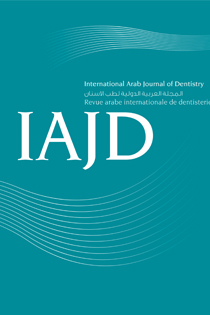Résumé
The aim of this study was to quantitatively evaluate the affinity of Streptococcus mutans to three types of orthodontic adhesives. 108 crown-specimens free of caries and other enamel defects were selected and calibrated to 4x3 mm2 with 2mm thickness. Thirty six standard maxillary lateral incisor brackets were bonded to enamel calibrated specimens with Transbond XT™ (control, group1) and compared respectively to two groups of similar samples bonded with “Transbond Plus™ Self Etching Primer and Transbond XT™”- group 2 (Fluor), “Clearfil Protect Bond™with Kurasper F™” -group 3 (Antibacterial with Fluoride). The cellular culture method for counting adhered “Kit Dentocult”. There was a significant difference in reducing bacteria in group 2 releasing fluoride when compared to group 1, and a non-statistically difference in group 3 incorporating antibacterial monomer MDPB. Transbond Plus™ enhances antibacterial capacity due to the fluoride release pattern called “burst effect”. Clearfil Protect Bond™ limits external action around brackets in an inhibitory bacteriostatic effect.

